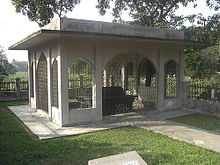Ghiyasuddin Azam Shah
| Ghiyasuddin Azam Shah | |
|---|---|
| Sultan of Bengal | |
| Reign | 1390–1411 |
| Predecessor | Sikandar Shah |
| Successor | Saifuddin Hamza Shah |
| Issue | Sikandar Shah |
| House | House of Ilyas Shah |

Ghiyasuddin Azam Shah (Bengali: গিয়াসউদ্দীন আজম শাহ; 1390–1411 CE) was the third Sultan of the first Iliyas Shahi dynasty of Bengal and one of the more widely known of medieval Sultans of Bengal. His tomb is situated in Narayanganj of current day Bangladesh.
Foreign relation
In the initial period of his reign, he led a military expedition and successfully conquered Kamarupa. But he mostly consolidated his power rather than annexation of territory during his reign. He sent envoys and gifts to Khwaja Jahan of Jaunpur.[1] He was also in good relationship with Young-Ie, the contemporary emperor of China. Ghiyasuddin sent ambassadors to China in 1405, 1408 and 1409 CE.[1] Young-Ie also exchanged envoys and valuable gifts for him. Ghiyasuddin also sent envoys to Mecca and Medina. He financially helped building two Madrasas, known as Ghiyasia Madrasa, in these two places.[1]
Interest in literature
Ghiyasuddin was a patron of scholars and poets. Persian poet Hafiz was in correspondence with him. Shah Muhammad Sagir, a Muslim Bengali poet, wrote his famous work, Yusuf-Zulekha, during Ghiyasuddin's reign. Also during his time Krittivasi Ramayan, a translation of the Ramayana into Bengali, was written by a Hindu poet, Krittibas Ojha.[1]
Ghiyasuddin's ruling ended by his death in 1411 CE.
See also
- Ilyas Shahi dynasty
- List of rulers of Bengal
- History of Bengal
- History of West Bengal
- History of India
| Preceded by Sikandar Shah |
Sultan of Bengal 1390–1410 |
Succeeded by Saifuddin Hamza Shah |